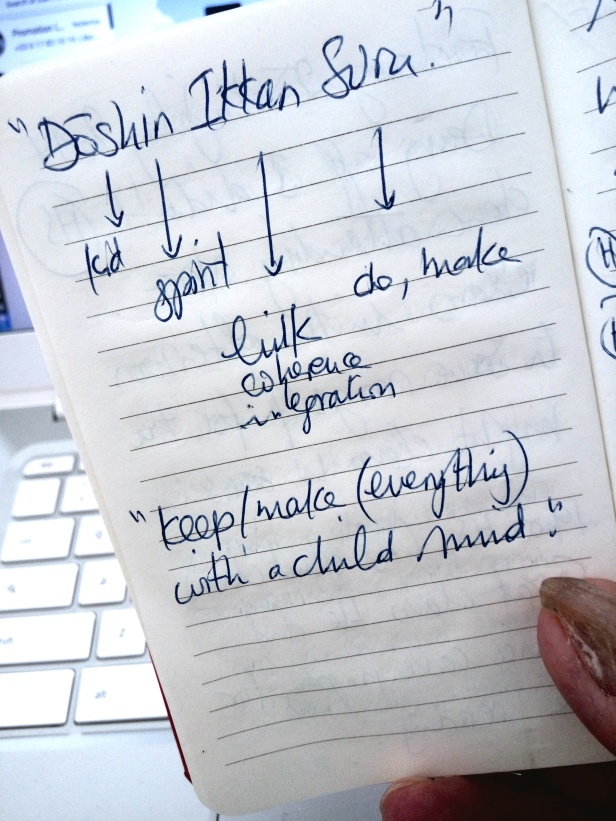From Shiro Kuma's Blog by kumablog

The last two classes with Hatsumi sensei were intense. Not physically, but mentally.
As he was late, I was tasked by Senō sensei to begin the class. When Sensei arrived he spoke again of the importance of Sakki, continuing the speech he gave after the Sakki tests of Friday.
This year is about Mutō Dori (1) and “zero”, but it is difficult to express it with words. The “natural” state is beyond the bio-mechanical movements. And Sensei gave us a few keys to get to it.
In his previous class Sensei said that we (Jûgodan), had to understand that Kankaku is more than only feeling, another Kankaku that comes from our six senses. As there’re two types of Kankaku, Omote and ura (physical and sensual), he said it is important to study 感覚の勉強, Kankaku no benkyō (2).
He said that at some point of our Budō progression, we have to let go of technique. To let go of Waza, means that you must learn them first.
When you do not try anymore to apply a technique, movement and distance bring them to life. Like in the Ishitobashi of last year (3), the spaces created between two points of contact, allow you to manifest natural movement.
Because you react mindlessly to the attacks of your opponent you become able to use 間玉利, Aida dama ri (4), to “take advantage of the sphere of possibilities existing between movements.”
But it is also 間魄利, Aida dama ri (5), where your spirit (dama/tamashii) in communion with 大自然, Daishizen (6), Mother nature, perceives everything in a natural way, and acts accordingly without you having the time to think.
More than ever, in these days of high international tension and terrorism, we have to develop combat awareness. The Sakki test is preparing us exactly to do that. Developing Sakki is the training the Jûgodan have to do now. We have entered the period of 戦前, Senzen, the period before war.
The Bujinkan system is regrouping actual fighting systems that have proved their efficiency on the battlefield for many centuries. It is not a sport, and it would be good that Bujinkan teachers let go a little, of the “flowery movements”, as criticized by Yamaoka Tesshû at the beginning of Meiji, and prepare their students to survive an actual encounter.
As Shidōshi, after the Sakki test, you have to train actively the two Kankaku (Omote and ura / physical and sensual), t in order to get the Shizen gyō un ryû sui, “the natural and ever-appropriate movement” that comes with long training.
We have to learn to “Move like the wind in the Kûkan, because strong people get stuck in the waza, and are easily defeated” said Sensei at the end of the class.
But then he added that “until Jûdan, training is basics and strength”, so teach your students properly, and train yourself to develop your Sakki.
This is why he said, “the Sakki test is only the beginning”.
So, don’t stop there! Continue your Benkyō until you reach the “zero state”.
________________
1. Mutō Dori: read my other posts in the blog. Mutō Dori is mainly about having the courage to go face the attacker even at the risk of getting killed.
2. Kankaku no benkyo:
感覚/kankaku/sense; sensation; feeling; intuition
勉強/benkyō/study|diligence|discount; reduction
3. Ishitobashi:
石飛ばし/ishitobashi/skipping stones (on a body of water); skimming stones. You can read more about it on several posts of this blog, written last year on this blog.
4. Aida dama ri:
間/aida/space (between); gap; interval; distance|time (between); pause; break|span (temporal or spatial); stretch; period (while)|relationship (between, among)|members (within, among)|due to; because of
玉/tama/ball; sphere; globe; orb|bead (of sweat, dew, etc.); drop; droplet|ball (in sports)|pile (of noodles, etc.)|bullet|bulb (i.e. a light bulb)|lens (of glasses, etc.)|bead (of an abacus)|ball (i.e. a testicle)|gem; jewel (esp. spherical; sometimes used figuratively); pearl|female entertainer (e.g. a geisha)|person (when commenting on their nature); character|item, funds or person used as part of a plot|egg|coin|precious; beautiful; excellent
利/ri/advantage; benefit; profit; interest
5. 魄/tama/tamashii/soul; spirit
6. Daishizen: 大自然/daishizen/nature; Mother Nature
7. Senzen: 戦前/senzen/pre-war days; before the war


…
 As often, before I return for training in Japan, I like to read the notes taken during previous trips. I don’t understand everything that I wrote, but I’m not the only one.
As often, before I return for training in Japan, I like to read the notes taken during previous trips. I don’t understand everything that I wrote, but I’m not the only one.







